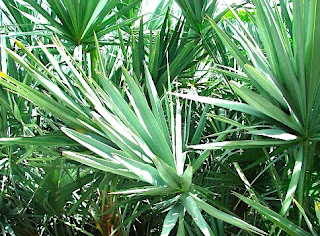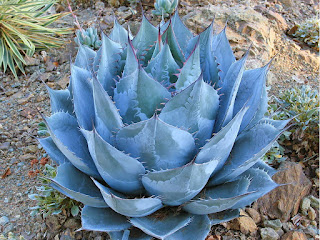Palo Verde Tree
Myrtillo Cactus
Also known as Bilberry Cactus, Cactus Myrtle, or Blue Candle, this is a large shrubby cactus that can grow up to 5 meters high. The fruit is edible and sold for consumption in Mexico. The bilberry cactus is fast growing. It’s a type of desert cactus, which requires little watering. During the summer months, you can water them once every two weeks and allow the soil to dry before watering again. In winter, you can water it as rarely as once a month.
Myrtilla Cactus
Barrel Cactus
As seen in the resort gardens at Tango Azul this cactus is native to the Sonoran Desert. It can grow to an impressive 6 ft. (1.3 m) in height and measure 2 ft. (60 cm) in diameter. Although the most common types grow between 3 and 4 ft. (0.9 – 1.2 m). The olive-green skin of the barrel cactus is covered in yellow hooked spines that grow on the ribs. This cactus species is drought-resistant and gets moisture from occasional rain that takes place. The barrel cactus flowers in the middle of June and these blooms are a delightful yellow or reddish-orange color.
Ferocactus Pringlei
Common name: Mexican Fire Barrel - brings year-round visual interest with bold red spines and a striking green body. It is virtually disease-free and deer resistant. Water regularly during the growing season, and suspend irrigation in winter. Allow the soil to fully dry out in between waterings, and do not leave in standing moisture. Plant in average, well-drained, gritty soil. Full sun is required unless the site is very hot, then provide partial shade. Propagate by offsets or seeds collected from over-ripe fruits. The cactus possesses sharp spines, be very careful when handling it, and do not place it near walkways.
Mexican Fire Barrel
Dracaena trifasciata - or Snake Plant
This well-known house plant thrives in the garden at the Tango Azul Resort La Ventana, Baja California Sur.
Known for its spiky, sword-shaped leaves, Dracaena trifasciata has also been called Mother-in-La's Tongue, Saint George's sword, Devil'sTongue. But most popular is also the name Snake Plant. The leaves boast an attractive array of colors, ranging from light to dark green and yellow. Its real power is the oxygen it produces at night which makes it attractive as an indoor plant too.
Snake Plant
Hibiscus
They are among the showiest plants in southern gardens. The many species offer an astonishing range of flower colors and numerous blooms over a long season. Colors range from white through pink to dark red, from yellow and apricot to orange. Individual flowers usually last only a day or two, but the plant blooms continuously in spring and fall.
The trumpet-shaped Hibiscus blooms are typically 3 to 8 inches in diameter with dramatic protruding stamens. Native to Asia, tropical hibiscus plants produce flowers constantly, but each blossom only lasts one day. The shrub is fast-growing and can add up to 24 inches per year, eventually reaching heights of up 15 feet when grown under ideal conditions. Plant in full sun, or partial shade. Regular feeding with a diluted fish emulsion fertilizer will keep it blooming vigorously.
Hibiscus
Bougainvillea
This colorful attractive plant is a genus of thorny ornamental vines, bushes, and trees belonging to the four o'clock family, Nyctaginaceae. Bougainvillea vines are fast growers and have stiff stems with thorns covered in heart-shaped leaves. Their vines can grow up to 40 feet tall with support. Low-growing, shrubby varieties only get a few feet tall and can be grown in containers.
Bougainvillea blooms come in purple, red, orange, white, pink, and yellow. But those blooms actually aren't blooms at all. The paper-like structures are a modified leaf called a bract that hides bougainvillea's true flowers: small, trumpet-shaped blooms of white and yellow.
Bougainvillea will grow best when given enough space to spread out and should be planted in an area that will allow them more than 6 hours of sunlight every day. They like gritty, loose soil. For the best bloom, trim all branches back to 20 feet or less. Bougainvillea blooms on new growth, so you can prune after each bloom cycle.
Bougainvillea roots are thin and can be easily damaged during transplanting. Water after planting and then weekly until the plant is established. Once it's established (which generally takes one to two years), stop watering it except in times of extreme drought. Bougainvillea likes it dry.
Feed the soil around it with compost. A 3-inch layer of compost in the spring is plenty. If you must fertilize, use palm or hibiscus food. Adding a bit Epsom salt is a simple way to increase the health of their blooms, and is something that you can include easily as a part of a normal routine.
Read more:
https://www.gardendesign.com/vines/bougainvillea.html
https://www.bhg.com/gardening/plant-dictionary/vine/bougainvillea/
https://www.hgtv.com/outdoors/flowers-and-plants/flowers/bougainvillea-care
Bougainvilla
Neem Trees
Azadirachta indica, commonly known as the Neem tree or Indian lilac, is a tree in the mahogany family Meliaceae. It is typically grown in tropical and semi-tropical regions.
Neem trees are attractive broad-leaved evergreens that can grow up to 30 m tall and 2.5 m in girth. Their spreading branches form rounded crowns as much as 20 m across. They remain in leaves except during an extreme drought, when the leaves may fall off.
The Neem leaf is used to treat leprosy, eye disorders, bloody nose, intestinal worms, stomach upset, loss of appetite, skin ulcers, diseases of the heart and blood vessels (cardiovascular disease), fever, diabetes, gum disease (gingivitis), and liver problems. Read more:
https://food.ndtv.com/health/benefits-and-uses-of-neem-a-herb-that-heals-1231051
Neem Tree
Lomboy Trees
Called Blackberry or Jambolan are evergreen trees in the family myrtaceae. The fruit of this tree is called Java plum or jamun. Consumption of this juicy jamun, purple fruit can provide relief from many health problems and diseases. Good quality jambolan juice is excellent for sherbet and sirup.
Seedlings grow slowly the first year, rapidly thereafter, and may reach 12 ft (3.65 m) in 2 years, and begin bearing in 8 to 10 years. Grafted trees bear in 4 to 7 years. No particular cultural attention seems to be required, apart from frost protection when young and control measures for insect infestations
The tree is grown as a shade tree for coffee in India. It is wind-resistant and sometimes is closely planted in rows as a windbreak. If topped regularly, such plantings form a dense, massive hedge. Trees are set 20 ft (6 m) apart in a windbreak. Read more:
https://hort.purdue.edu/newcrop/morton/jambolan.html
Lomboy Tree
Palm Sago (Cycas revoluta)
A popular, low-growing palm that is seen in most tropical landscapes. Leaves are dark green and glossy on stiff stems. The leaves develop from a rosette and limbs can be pruned if a trunk from Sago Palm is desired. Makes a nice specimen plant or can be grown in large containers on patios or balconies. This is actually a cycad, not a true palm.
Zones 9-11. Height and Width. 4-8' H x 6-10' W. Water regularly or more frequently in extreme heat. Fertilize in spring and summer with a well- balanced fertilizer, specially designed for palms.
Seeds of the sago palm are usually bright orange to red in appearance. Like many large seeds, be prepared to wait patiently, as sago palm seed germination may take several months. To begin growing sago palm from seed, growers will need a quality pair of gloves, as the seeds do contain toxins. Read more:
http://yourplantinfo.com/gallery/palm/sago-palm
Saw Palmetto
Known scientifically as Serenoa repens, Saw palmetto is a slow-growing, clumping, multi-trunked palm that typically grows 5 to 10 feet tall and spreads 4 to 10 feet wide. Plant a mass of silver saw palmettos under a tree. This native plant tolerates a range of conditions and provides wonderful textural interest beneath new or established trees.
It has stout stems that usually crawl across the ground and produce fan-shaped fronds. While most forms have green leaves, leaf color is variable, with silver to blue-silver forms. In the horticultural trade, forms with more silvery foliage are sometimes given names including ‘Sericea’, ‘Cinerea’, or 'Glauca’.
Position plants away from walkways, driveways, play areas, or any place where the saw-like teeth along the stems might cause harm. This plant provides a beautiful backdrop for mixed borders and works well as a privacy hedge or foundation planting. Saw palmetto prefers full sun but will grow in almost any light conditions. It will benefit from regular watering at first but will be very drought-tolerant once established.
.
<><><><><>
.



































